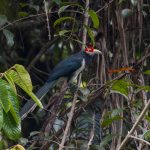The National Audubon Society just dropped a bombshell of a report detailing 20 common North American birds whose populations have declined over the last 40 years. The list of birds, all of which have lost at least half their populations in just four decades, is both surprising and disconcerting, indicating that even the most robust species may be vulnerable to our rough and thoughtless treatment of this planet.
A new analysis by the National Audubon Society reveals that populations of some of America’s most familiar and beloved birds have taken a nosedive over the past forty years, with some down as much as 80 percent. The dramatic declines are attributed to the loss of grasslands, healthy forests and wetlands, and other critical habitats from multiple environmental threats such as sprawl, energy development, and the spread of industrialized agriculture. The study notes that these threats are now compounded by new and broader problems including the escalating effects of global warming. In concert, they paint a challenging picture for the future of many common species and send a serious warning about our increasing toll on local habitats and the environment itself.
Among the most severely impacted species on Audubon’s list of 20 Common Birds in Decline are the following:
- Northern Bobwhite populations are down 82 percent and have largely vanished from northern parts of their range in Wisconsin, Michigan, New York and New England mainly due to loss of suitable habitat to development, agricultural expansion and plantation-style forestry practices.
- Evening Grosbeaks that range from mountains of the west to northern portions of the east coast show population declines of nearly 78 percent amid increasing habitat damage and loss from logging, mining, drilling and development.
- Northern Pintail populations in the continental U.S. are down nearly 78 percent due to expanding agricultural activity in their prairie pothole breeding grounds.
- Greater Scaup populations that breed in Alaska, but winter in the Great Lakes and along Atlantic to Pacific Coasts are being hard hit by global warming induced melting of permafrost and invasion of formerly-southern species; populations are down approximately 75 percent.
- Eastern Meadowlarks, down 71 percent, are declining as grasslands are lost to industrialized agricultural practices. Increased demand for biofuel crops threatens increased agricultural use of lands that are currently protected, making both Eastern and Western Meadowlarks even more vulnerable.
- Common Terns, which nest on islands and forage for fish near ocean coasts, lakes and rivers, are vulnerable to development, pollution and sea level rise from global warming. Populations in unmanaged colonies have dropped as much as 70 percent, making the species’ outlook increasingly dependent on targeted conservation efforts.
- Snow Buntings, which breed in Alaska and northern Canada, are suffering from the loss of fragile tundra habitat as global warming alters and disrupts the Arctic’s delicate ecological balance; populations are down 64 percent.
- Whip-poor-wills, down 57 percent, are vulnerable to fragmentation and alteration of their forest habitat from development and poor forest management practices.
Rounding out this list are familiar birds like Boreal Chickadee, Loggerhead Shrike, Field Sparrow, Grasshopper Sparrow, Black-throated Sparrow, Lark Sparrow, Common Grackle, American Bittern, Rufous Hummingbird, Horned Lark, Little Blue Heron, and Ruffed Grouse.
Audubon does point out that these Common Birds in Decline are not in immediate danger of extinction, even though some of them are perilously close to the traditional 500,000 bird threshold that designates “common†status. Though I’m just a single observer, I can certainly vouch for the apparent decline of some of these species. Just recently, I either barely sighted or outright missed species like Grasshopper Sparrow and Boreal Chickadee in places where they should have thrived. Northern Pintail was uncharacteristically rare in the NYC area this winter, though buntings and larks seemed to do well by the ocean. But by the same token, one set of eyes is insufficient to track these changes; Common Grackles may be taking a hit in other places, but they couldn’t be more abundant around here. That’s why citizen science initiatives like the Christmas Bird Count are so critical in producing both the quantity and quality of data ornithologists require to track population trends.
How about you? In your observations of North American avifauna, have you been missing these birds or other previously common ones?













We’ve definitely seen the decline of the Grouse and Bobwhite here in NJ. All Bobwhites in NJ these days are stocked birds and Grouse are limited to a few very small areas. Deer browsing has destroyed the forest understory where grouse once thrived.
Funny, Grouse are pretty darn common here in Upstate New York. Boreal Chickadee has in my opinion increased in the Adirondacks and Evening Grosbeak you have to remember wasn’t even on the east coast until the 1840’s and didn’t peak until the 1970’s. Since then there has been a huge range reduction, but there may be other reasons such as the spraying to remove Spruce Budworm which also affects other boreal birds such as Cape May and Bay Breasted Warblers. We also have to remember that humans played a major role of allowing species like Meadowlark, Grasshopper Sparrow and Bobolink to enter the Northeast by removing the forests. As agriculture has diminished the forests have returned, bad for the Bobolinks good for Grouse and Barred Owls. I think its premature to start hitting the panic button about these species, but certainly something we need to keep in mind.
Those are really good points you both make. Often, when we list the ways humans have affected habitat, allowing deer to exceed sustainable numbers fails to come to mind. Also, it makes sense to note that one species’ loss is another’s gain. Too bad that increase in Boreal Chickadees didn’t extend to Wakeley Mountain!
Contra Will, I am not sure that all of these losses are being compensated by gains for other species. In my area, at least, both grassland and woodland birds are getting hammered because the dominant landscape changes are not from one habitat form to another but from natural habitat to subdivision. I’m sure that most other major metropolitan areas have undergone similar changes. I watched this process happen in Central Jersey, too. There is some question about what we should consider the ‘normal’ distribution for certain species, but I think that we are seeing more than retrenchment to pre-Colonial ranges.
Just read this list and was surprised to see the Common Grackle on the list. I am on Long Island, about the middle of the Island, and among House Sparrows, Starlings and Mourning Doves, the Common Grackle is one of my most frequent daily visitors. They leave for the coldest months, then return in literal droves some days.
Lyn
Seems like the Audubon and the USFWS are both turning a blind eye to the fact that accipiter raptors, which prey on all of the birds on this list, have exploded in numbers. I have seen up to 3 Cooper’s Hawks hunting down cardinals and bluejays near my feeders. Raptors, specifically accipiters, like the Peregrine, Cooper’s, Goshawk, and Sharpies, get all of the benefits of protection for their aerial dominance and “glamour”, and are costing us many of the birds on this list. Based on personal experience witnessing it and from friends and notes all over the internet, raptors are more common than certain organizations would like to admit. Prey species are being descimated in the texas area and nowhere in the article by the Audubon is there a mention of the exploding population of accipiter raptors. The same Audubon website shows the count, according to their Christmas Bird Count project, of Cooper’s Hawks from around 700 in 1970 to almost 8000 in 2006, over a 1000% gain. These are only the hawks counted. I can only imagine how many are not counted. Like any conservation project, including bears, wolves, and any other protected animal, there comes a point when you have to question whether too much conservation is good for the overall environment. This might be a wake up call but everyone at Audubon is hitting the snooze button. I would love to hear a biologist talk about the role of predators with regard to these numbers. The Audubon obviously won’t link the two since they have worked hard to protect hawks and falcons, at great cost and with great success. Maybe too much success?. They would be shooting themselves in the foot to link the two phenomena. They and other agencies like the USFWS get lots of money from taxpayers to protect the all native birds, especially raptors. I’m sure they wouldn’t want to lose that funding.
I think John raises an interesting point that universal decline is not even. Hence a species may be in decline over all, but may actually be increasing in some areas due to changes in habitat. This has been true of late for Whip-poor-Will. But I will agree that sub-division is a bigger threat for most species than Global Warming at the moment, although that will rear its ugly head within the next 25 years.